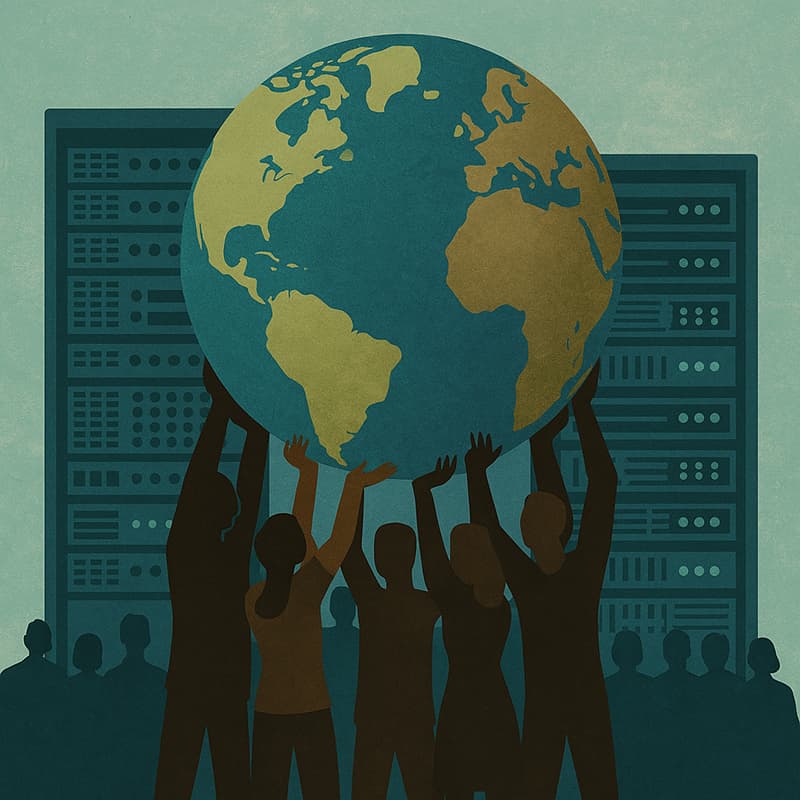In the 21st century, infrastructure is no longer just about roads, railways, or power grids. It is also about the digital systems that now shape everything from how we communicate to how governments deliver services. Cloud servers, data centers, internet platforms, and digital identification systems have become the nervous system of modern society.
But most of this infrastructure is not public. It is in the hands of a small number of powerful private corporations, many of which operate beyond the reach of democratic accountability. As the world becomes more reliant on digital systems, the question of who controls them is no longer technical. It is political.
If democracy is to survive in the digital age, we must treat digital infrastructure as a public good. This means not only ensuring access for all, but also placing ownership and control in the hands of the people.
The Privatization of the Digital Commons
Much of the internet was originally built with public funding. Universities, research institutions, and government bodies played a central role in creating the foundational protocols and networks. But as private capital flooded into the digital space in the 1990s and early 2000s, the public origins of the internet were quickly erased.
Today, a handful of corporations own the vast majority of the digital infrastructure that underpins the global economy. These include cloud services, messaging apps, social media platforms, and digital payment systems. Even state services in many countries rely on third-party platforms to operate.
This concentration of ownership has created a new form of digital feudalism. Just as feudal lords once controlled access to land and resources, tech giants now control access to essential digital tools. The consequences are widespread: surveillance of users, algorithmic manipulation, corporate censorship, and the commodification of human behavior.
Why Public Ownership Matters
Public ownership of infrastructure is not a new idea. Roads, water systems, schools, and hospitals have long been understood as essential public goods. They are funded collectively and governed (ideally) in the public interest. The same logic must now be applied to digital systems.
When digital infrastructure is publicly owned, it can be designed to serve people instead of profit. Services can be built around democratic values such as transparency, accessibility, and fairness. Citizens can have a say in how platforms are governed, how data is used, and what protections are in place.
In contrast, when infrastructure is private, decisions are made in boardrooms. Profits take priority over social responsibility. This creates a dangerous gap between public needs and private incentives. The public sector, when empowered and resourced, can close this gap.

Global Inequality and Digital Colonialism
The issue of digital infrastructure is also a global one. Many countries in the Global South are heavily dependent on platforms and technologies developed and controlled in the Global North. This creates a new form of dependency, where local governments must adapt to systems they do not control and often do not understand.
Digital colonialism replicates the logic of past empires – extracting value from populations without returning benefits or autonomy. It undermines local sovereignty and stifles the development of homegrown alternatives. Worse, it often goes hand in hand with resource extraction, environmental harm, and data exploitation.
To resist this new colonialism, global solidarity is essential. International cooperation can help build open-source platforms, invest in public data centers, and share technical expertise. A progressive international approach must prioritize the creation of a fair and decentralized digital order.
Building a Democratic Digital Future
What would a truly democratic digital infrastructure look like? It would be governed by public institutions that are transparent and accountable. It would be built on open standards and open-source software to allow independent oversight and adaptation. It would prioritize privacy, data protection, and user control.
In practice, this could mean municipally run broadband networks that guarantee universal access. It could mean public cloud services operated by cooperatives or government bodies. It could mean independent watchdog agencies that oversee algorithmic decision-making and protect digital rights.
Crucially, it also means involving people in the process. Citizens should have the right to participate in decisions about the platforms they use. This is not only a matter of ethics – it is a matter of survival for democracy in an age where private systems increasingly mediate public life.
Conclusion
We are at a turning point. As digital systems become more central to how we live, work, and govern, we must ask ourselves what kind of digital world we want to live in. One shaped by profit and control? Or one shaped by justice and collective power?
If we choose the latter, we must treat digital infrastructure as a public good. That means taking bold steps toward public ownership, democratic governance, and global cooperation. The fight for digital justice is not separate from the fight for economic or social justice. It is part of the same struggle – and it’s one we cannot afford to lose.




